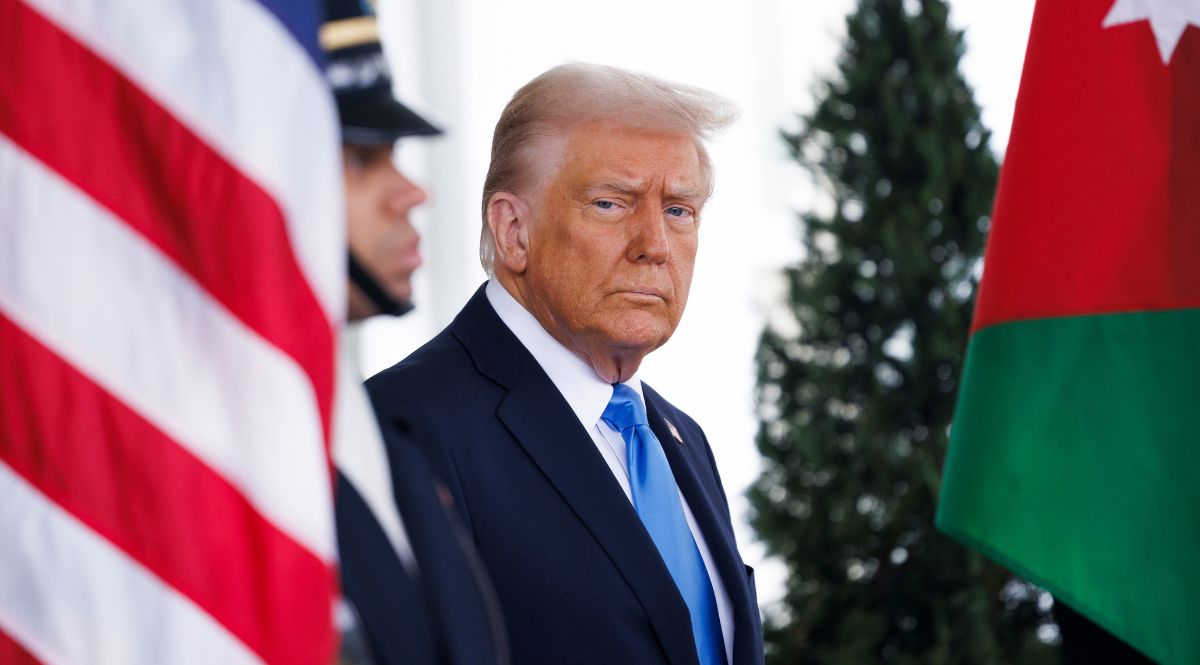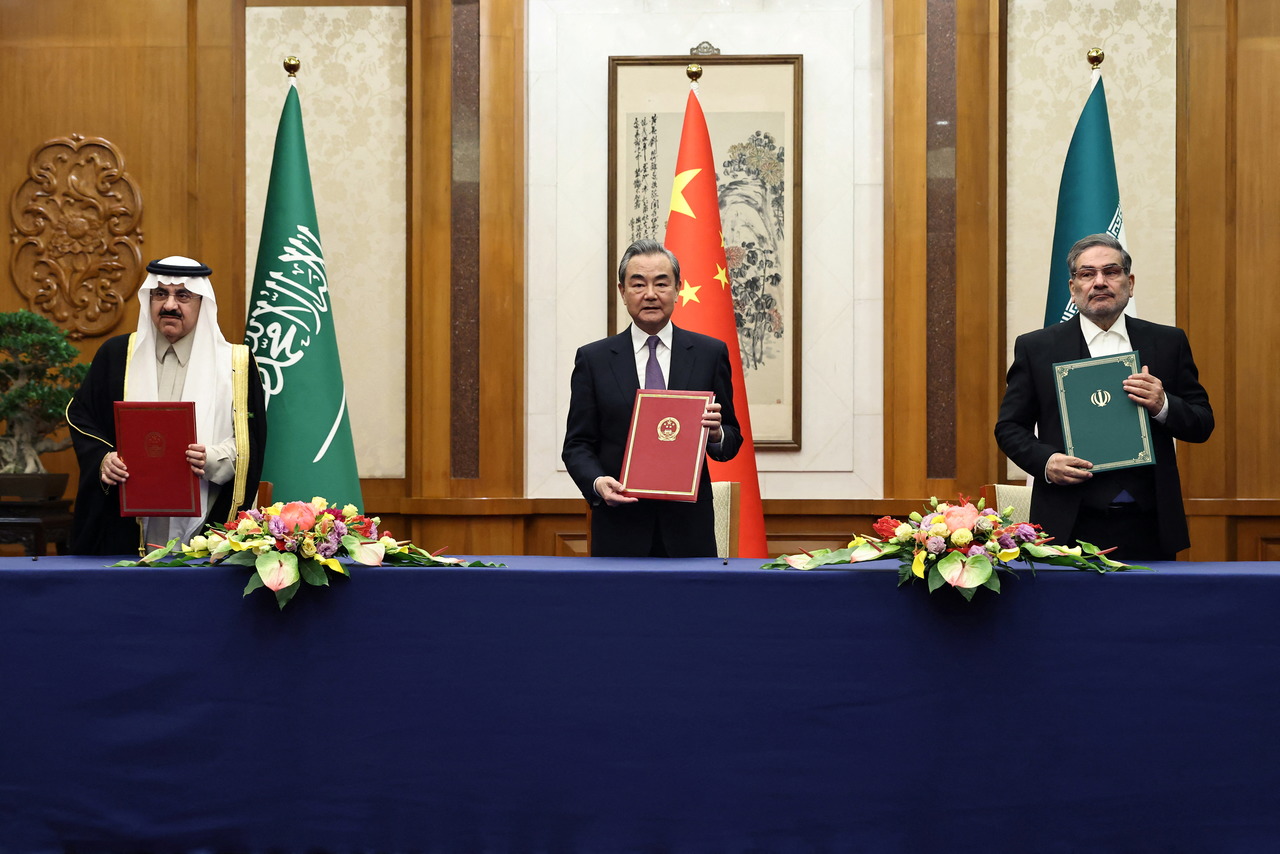Trump's Return to the White House Leads Arab States to Review Relations
The beginning of Donald Trump’s second term coincides with changes in the Middle East. The U.S. president wants to take advantage of them to force Arab states to pursue policies favourable to Israel and U.S. economic interests. This is indicated by Trump’s offer to Saudi Arabia to make a large investment in the U.S. in exchange for his first official foreign visit and by his call for OPEC countries to increase oil production. The priority of Arab countries will be to convince the new administration to maintain U.S. involvement in the security of the region, with restraint towards Iran.
 Aaron Schwartz / Zuma Press / Forum
Aaron Schwartz / Zuma Press / Forum
Recent Developments in the Region
The Hamas attack on Israel in October 2023 indirectly triggered numerous political processes in the region. Israel’s weakening of Hezbollah and the collapse of Bashar al-Assad’s regime in Syria have reduced Iran’s role in shaping the Middle East order. The partial collapse of the so-called “Axis of Resistance” has allowed Israel to strengthen its negotiating position in the conflict with the Palestinians and Lebanon, as well as to occupy additional territory in Syria. The latter state is simultaneously dealing with a political transformation and the need to rebuild state institutions and infrastructure, devastated after nearly 14 years of civil war. The changes in Syria are particularly favourable to the interests of Qatar and Turkey, which for years have been supporting the groups currently taking power, but also to Saudi Arabia, which sees the change as an opportunity to increase its influence in the region. The kingdom, in cooperation with the U.S., France, Qatar, and Egypt, contributed to the election of a new president of Lebanon. This helped to ease the political crisis there and the establishment of a new government, which together weakened the role of Hezbollah on the Lebanese political scene.
Regardless of the political changes, the countries in the region (apart from the monarchies in the Persian Gulf) are facing financial and debt crises as a result of structural problems in their economies. These are mainly caused by the dominance of state institutions and the informal sector, corruption, and development based on capital-intensive, large-scale state investments financed by foreign loans. Considering the accompanying demographic conditions—young and a high level of unemployment—these factors increase the risk of destabilisation in the Middle East, especially in the face of the frustration of Arab societies over Israel’s seeming impunity despite accusations of war crimes in the Gaza Strip.
Policy Objectives of the New U.S. Administration
Compared to Trump’s first term, the statements made so far and the people appointed to various positions in the administration (e.g., Steve Witkoff, an investor named U.S. special envoy to the Middle East), indicate an intensification of Trump’s transactional approach and the prioritisation of Israel’s interests in the region. This was emphasised by the president’s statement after Prime Minister Benjamin Netanyahu’s visit to Washington in February, in which he suggested that the Palestinian population should be permanently resettled from the Gaza Strip to Egypt and Jordan, de facto ethnic cleansing. He also warned that opposition from these countries to his suggestion could result in the withholding of U.S. aid. He also declared that Saudi Arabia would not make the normalisation of relations with Israel contingent on the implementation of a two-state solution. The kingdom strongly denied this claim while also criticising the president’s assertion that the U.S. will control the Gaza Strip and remove the local population. The call to OPEC countries to increase oil production in order to lower the global price of oil was also rejected by the monarchy. Trump indicated that he might choose Riyadh as the destination for his first foreign visit if Saudi Arabia invested $600 billion in the U.S.
The Trump administration has also reinstated the “maximum pressure” policy on Iran, instituted in his first term. Its aim is to strengthen sanctions to make it completely impossible for Iran to export oil, with the restrictions extended to include individuals and companies from the United Arab Emirates (UAE). During the election campaign, Marco Rubio, now the Secretary of State, indicated that Israel “has the right to react disproportionately” to an attack, a statement made after Iran’s massive missile attack on Israeli territory, suggesting greater U.S. approval of escalation against Iran while expressing the will to work out a new nuclear agreement with that country.
The new administration also hinted at limiting U.S. involvement in Middle Eastern security. At the beginning of February, reports emerged that the Department of Defense was developing plans to withdraw U.S. troops from Syria (about 2,000 are there), where they supported fighters of the Syrian Democratic Forces in the fight against ISIS, which has increased its activity significantly in recent months. In addition, the suspension of foreign funding by the Trump administration in January has affected financing of the Lebanese army, as the U.S. was previously the largest donor. Considering the importance of a stronger Lebanese army to the further implementation of the ceasefire between Hezbollah and Israel, an indirect effect of this decision may be a renewed escalation in southern Lebanon.
Conflicts of Interest
Although Trump in his first term generally favoured most Arab leaders, especially the monarchs in the Persian Gulf or the Egyptian president, the changes in the region have led to differentiation in these countries’ approach to the U.S. in the president’s second term. This applies above all to Saudi Arabia, which has become stronger economically and politically in recent years, gaining the status of a regional leader. It also is attempting to take advantage of the partial disintegration of the Iranian-led “Axis of Resistance” to increase the cohesion of the Arab bloc, emphasising growing assertiveness towards the U.S. This has had a positive impact on Saudi Arabia’s perception in the region, where U.S. policy has been viewed extremely negatively since the beginning of the war in the Gaza Strip. Saudi Arabia and other countries in the region—Egypt, Lebanon, and Qatar—also are maintaining a policy of balance with respect to Russia and Ukraine since the invasion in 2022, not joining the sanctions against Russia, but condemning the aggression at the UN. This contributed to Saudi Arabia being chosen as the venue for the meeting between Trump and Vladimir Putin, increasing the kingdom’s importance as a global actor. Countries in the region have also developed economic and political cooperation with China, including joining BRICS (e.g., UAE, Egypt), an organisation that is viewed positively by both the Arab population and political elites.
At the same time, the Arab states want the U.S. to remain involved in ensuring the security of trade routes in the Gulf and the entire region. The presence of U.S. troops in Qatar is crucial for that country’s stability, while in Iraq and Syria they are helping to fight terrorist organisations. Saudi Arabia is seeking a defence treaty with the U.S., which could become part of the normalisation of its relations with Israel. The kingdom’s push for this form of security cooperation stems from the lack of U.S. response after Iran’s attacks on Saudi Arabian oil infrastructure in 2019. This contributed to a loss of confidence in U.S. support and a change in Saudi Arabia’s policy towards Iran, which resulted in a softening of the Saudi-Iranian rivalry and the restoration in 2023 of diplomatic relations, suspended in 2016. U.S. security support is also crucial for the regimes in Egypt and Jordan, but maintaining it at the expense of accepting refugees from the Gaza Strip risks internal destabilisation. In Egypt, Hamas supporters are seen as a threat to the president’s power, while in Jordan, more than half of the population has Palestinian origins and strongly rejects the possibility of further Palestinian resettlement.
Conclusions and Perspectives
Trump will continue to pressure the Arab world to cooperate with Israel regardless of the situation in Palestine. Some Arab governments may only be willing to agree to this in exchange for security guarantees, but for Egypt and Jordan this may mean having to re-evaluate their relationship with the U.S. It may be difficult to reach such agreements and may lead to international and internal tensions due to the negative attitude of Arab societies towards the U.S. and Israel. From Saudi Arabia’s perspective, Trump’s statements regarding the future of the Gaza Strip, his extremely pro-Israel policy, and his attempts to extort economic benefits threaten its position in the region, forcing it to choose between security-relevant relations with the Trump administration and the loss of credibility in the eyes of its neighbours. The return of the U.S. to a policy of “maximum pressure” on Iran could also destabilise the Middle East. If Arab countries join in, Iran could launch direct attacks on their territories and assets.
It is in the EU’s interest to maintain the U.S. military presence in Syria and Iraq, states where ISIS has resumed its destabilising activities in recent years. Trump’s previous statements in this regard should encourage EU countries to consider greater involvement in the security of the southern neighbourhood within the framework of EU mechanisms, also in cooperation with Arab countries.




.jpg)
